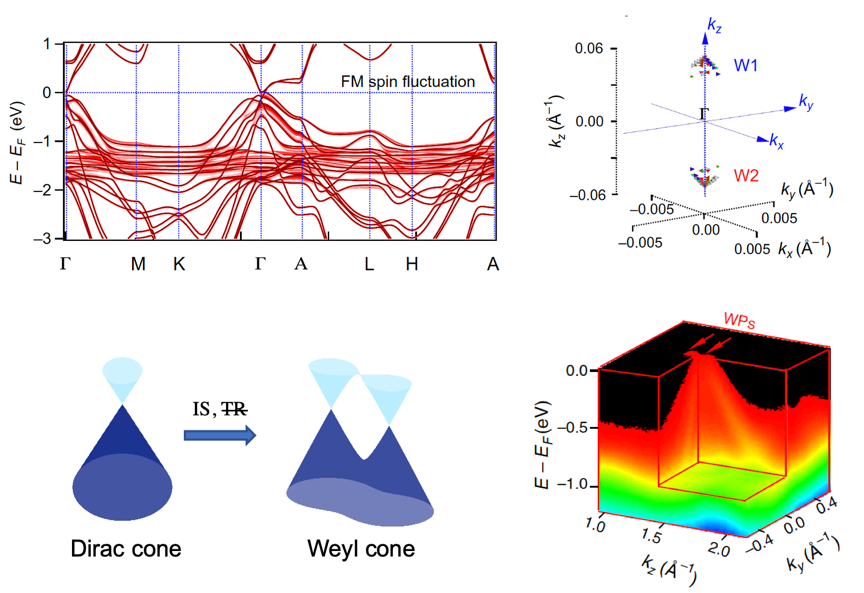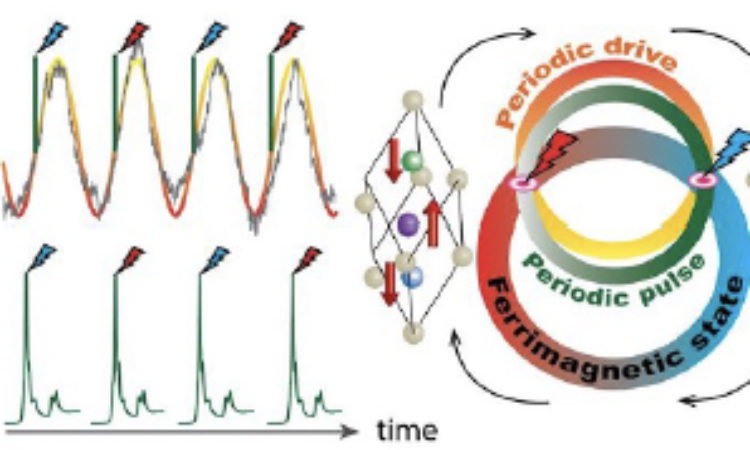Spin fluctuation induced magnetic Weyl semimetal state in the paramagnetic phase of EuCd2As2
 By Junzhang Ma, Paul Scherrer Institute
By Junzhang Ma, Paul Scherrer Institute
Based on article published in Science Advances
The realization of Weyl semimetals (WSMs) with time-reversal symmetry broken is one of the central issues in the research of novel topological phases in condensed matter. Weyl semimetals are one kind of exotic materials that host massless doubly degenerate Weyl fermions in non-centrosymmetric or magnetic systems with inversion symmetry or time-reversal symmetry broken. On one hand, in recent years, the nontrivial electronic structures of Weyl nodes have been identified in several non-centrosymmetric systems. On the other hand, as a long-range magnetic order can break time-reversal symmetry, great efforts have been made to search for WSMs in magnetically ordered systems. However, till this work there is no well-defined spectroscopic evidence for the realization of WSM in magnetic systems.
A team led by researchers (Prof. Ming Shi, and Dr. Junzhang Ma) from Paul Scherrer Institute experimentally demonstrated that spin fluctuations without long-range static magnetic order could also effectively rather than spontaneously break time-reversal symmetry and then Weyl fermions could emerge in the paramagnetic phase of EuCd2As2. Owe to the large facility Swiss Light Source (SLS), this work is down mainly by using angle-resolved photoemission spectroscopy experiments at the SIS-HRPES (Surface and Interface Spectroscopy–High-Resolution Photoemission Spectroscopy) beamline in SLS combined with transport, magnetic susceptibility, ESR, μSR, and first-principles calculations. The results suggest that the spontaneous breaking of time-reversal symmetry is not necessary for the existence of the WSM phase in the centrosymmetric systems as this electronic phase can also be driven by magnetic fluctuations, and the WSM state can emerge in a wider range of condensed-matter systems than previously thought.
Analogy to the vacuum fluctuation in particle physics, this work reveal that magnetic Weyl fermions should always exist induced by spin fluctuations in the background of magnetic Dirac semimetals. The magnetic Weyl fermions can be created and annihilated in pairs with very short time fluctuations. When the fluctuation become slow enough, we can experimentally observe the Weyl fermions. These kinds of fluctuations, in Weyl node and charge sign, are sensitive to the magnetization, which can be tuned by an external magnetic field. The fact that Weyl nodes and their topological charge adjust to the orientation of the magnetization, which is itself tunable, could be promising for future spintronic applications.

Left-up), electronic band structure along high symmetry lines in EuCd2As2 with strong FM spin fluctuations. Right-up), The fluctuated Weyl points in momentum space. Left-down), Schematic of the formation of magnetic Weyl cones by effective time reversal symmetry breaking. Right-down), Experimental observation of fluctuated dynamic Weyl points.



